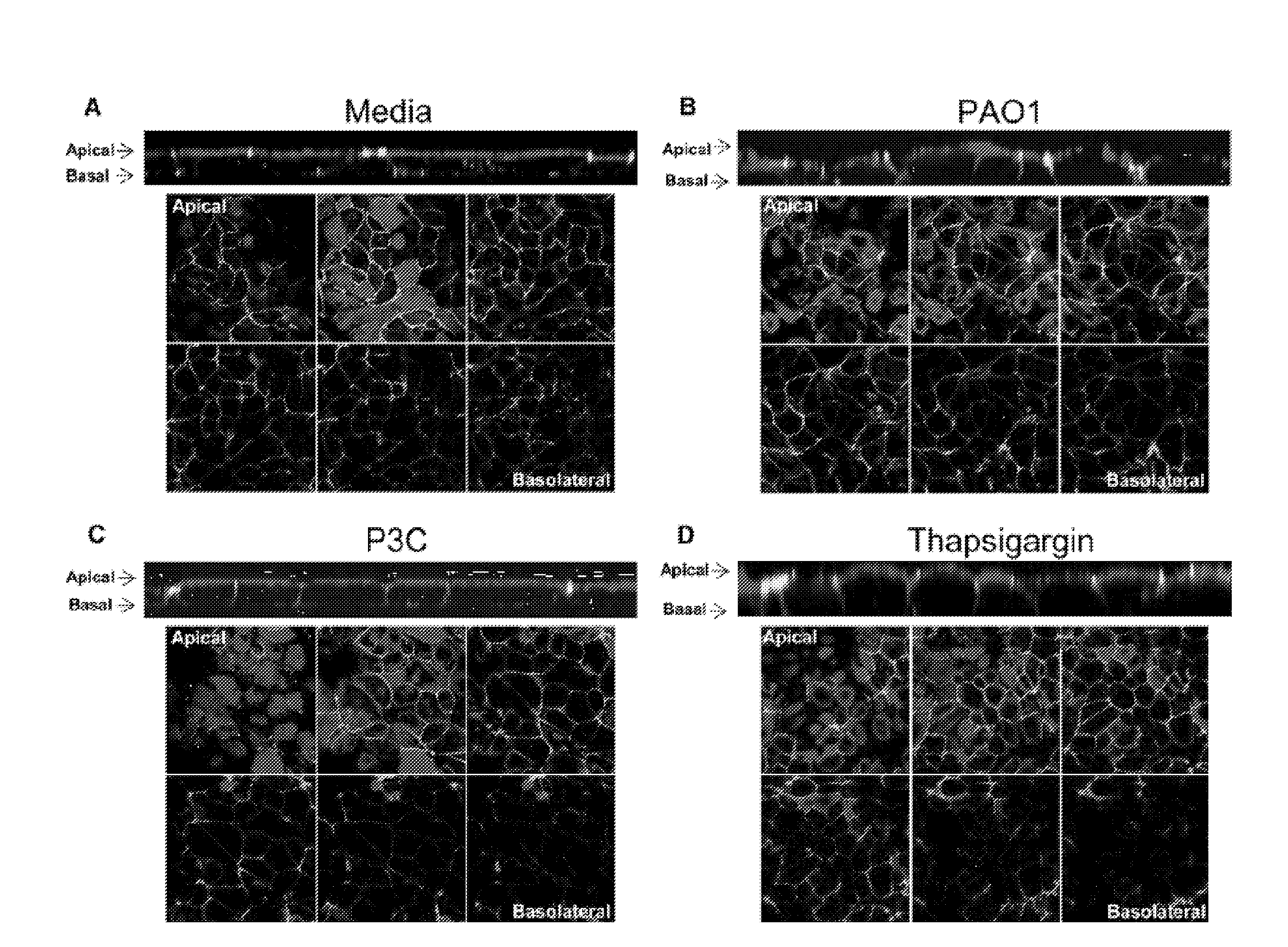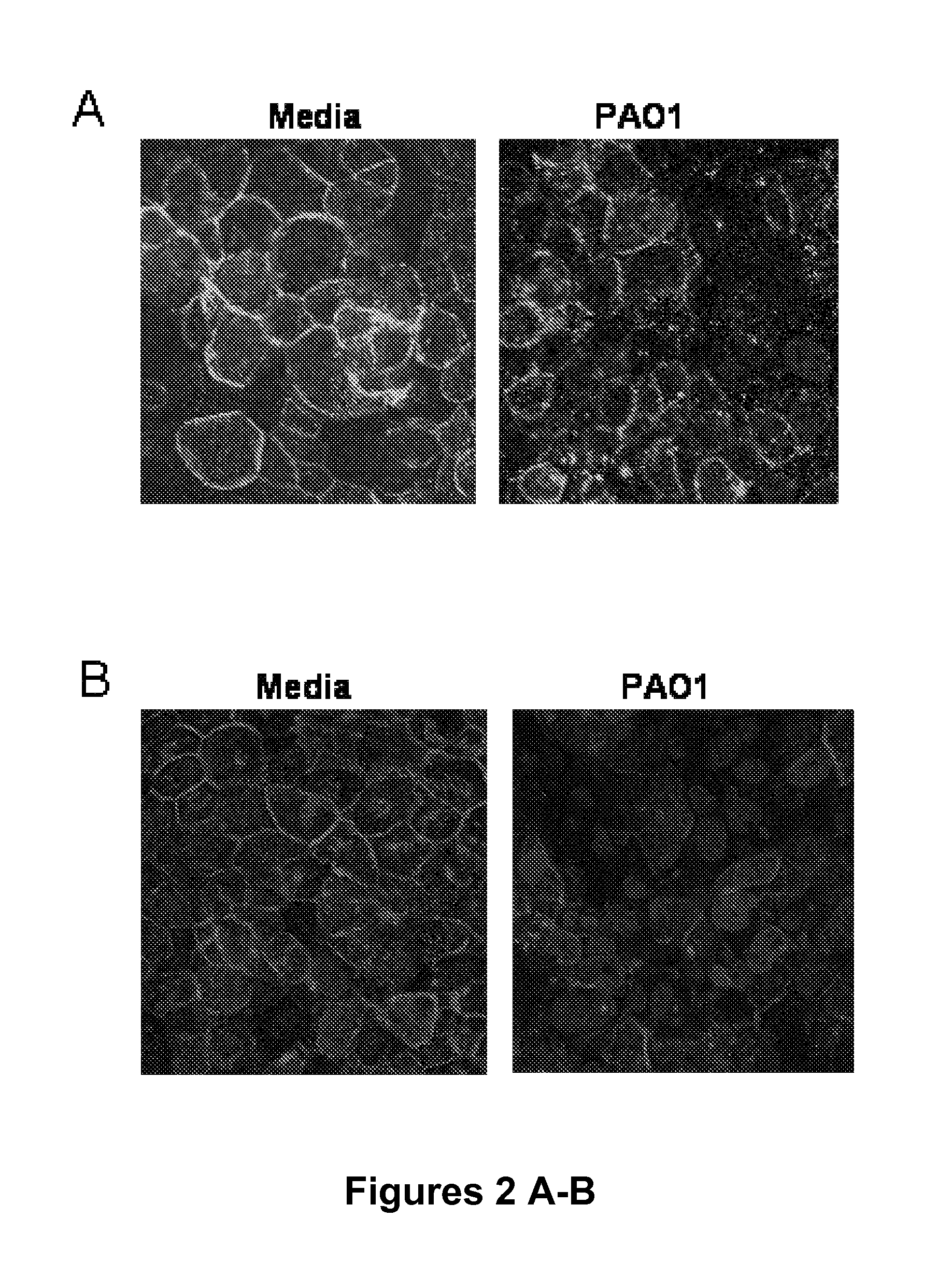Uses of calpain inhibitors to inhibit inflammation
a technology of calpain inhibitors and inhibitors, which is applied in the direction of enzymology, peptides, drug compositions, etc., can solve the problems of prohibitively difficult or expensive production, excessive inflammatory responses in the airway, and blockage of air exchange and respiratory failure, so as to reduce the activity of calpain 2 and reduce the activity
- Summary
- Abstract
- Description
- Claims
- Application Information
AI Technical Summary
Benefits of technology
Problems solved by technology
Method used
Image
Examples
example 1
Bacterial Activation of TLR2 Modulates Epithelial Barrier Function
[0366]Bacterial stimulation of TLR2 signaling initiates chemokine expression in epithelial cells which is followed by the recruitment of phagocytes into the airway lumen. This process can be linked to changes in the epithelial cell-cell junctions to facilitate the movement of phagocytes into the airway without compromising the barrier function of the epithelium. TLR2 activation can be accompanied by the activation of Ca2+ fluxes in epithelial cells and Ca2+-dependent proteases, such as a calpain, can be involved in modifying epithelial junctional proteins in response to TLR2-specific ligands. Using 1HAEo-human airway cell lines as well as human small airway epithelial cells in primary culture, P. aeruginosa or the TLR2 agonist Pam3Cys activates calpain 2, was shown cause cleavage of the transmembrane proteins E-cadherin and occludin. Calpain 2 is recruited to the epithelial membrane in response to TLR2 ligands and is ...
example 2
P. aeruginosa Stimulates the Redistribution of Occludin and E-Cadherin Without Loss of Barrier Function
[0373]To demonstrate that TLR2 or Ca2+ signals induce changes in epithelial junctions, the distribution of the membrane-spanning junctional proteins occludin and E-cadherin were imaged. The “chicken wire” distribution of both occludin (FIG. 2A) and E-cadherin (FIG. 2B and FIG. 11B) was altered following 6 hr exposure of airway cells to P. aeruginosa PAO1 or PC3. Despite loss of occludin and E-cadherin at the cell borders, there was no concomitant decrease in the transepithelial resistance measured across the monolayers over this time period (FIG. 2C); nor was there an increase in permeability to fluorescent dextran (FIG. 2E), or to bacteria across the paracellular space (FIG. 2E) indicating that the barrier function of the monolayer remained intact (FIG. 2F).
example 3
Occludin and E-Cadherin are Targets for Calpain Proteolysis
[0374]Occludin and E-cadherin are both substrates for proteases known to be responsible for their dissociation from the cell junctions (Bojarski et al., 2004; Rios-Doria et al., 2003; Zhu et al., 2006). Both occludin and E-cadherin are known substrates for proteases (Bojarski et al, 2004; Rios-Doria et al, 2003; Zhu et al, 2006). Among the many cellular proteases that can target these proteins, Ca2+-dependent calpains were examined to determine if TLR2 induced Ca2+-flux can initiate activity (Shao et al, 2006). In an in vitro experiment, exogenous calpain activated by the addition of Ca2+ degraded occludin and E-cadherin, but not claudin-1 or JAM-1 (FIG. 11B), indicating that calpains target specific junctional proteins. Autolysis of calpain is readily detectable in the presence of Ca2+ and confirms calpain activation in vitro (FIG. 11B).
[0375]Calpain is Activated by TLR2 Signaling
[0376]Calpains 1 and 2 as well as the endoge...
PUM
| Property | Measurement | Unit |
|---|---|---|
| diameters | aaaaa | aaaaa |
| diameters | aaaaa | aaaaa |
| pH | aaaaa | aaaaa |
Abstract
Description
Claims
Application Information
 Login to View More
Login to View More - R&D
- Intellectual Property
- Life Sciences
- Materials
- Tech Scout
- Unparalleled Data Quality
- Higher Quality Content
- 60% Fewer Hallucinations
Browse by: Latest US Patents, China's latest patents, Technical Efficacy Thesaurus, Application Domain, Technology Topic, Popular Technical Reports.
© 2025 PatSnap. All rights reserved.Legal|Privacy policy|Modern Slavery Act Transparency Statement|Sitemap|About US| Contact US: help@patsnap.com



